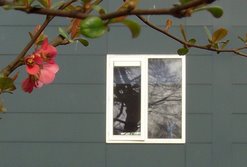
Evie is an expert in photographing birds. Recently she put a new one on her blog. Before I saw this one, I also tried to capture a bird myself but I forgot to take the salt with me to put it on its tail. They say here in Holland that before you can catch a bird you have to put salt on its tail. Then I tried but it turned out not to work, maybe the wrong kind of salt. Anyway, imagine my happiness when I came home and saw that Janine had bought two fake birds.
I have the greatest admiration for people who have the patience to picture wildlife, especially birds. It yields phantastic photos, because the watcher, like the photographer, expects the animal to run or fly away any moment. This occurs 9 of 10 times to the photographer, who benefits the watcher who can be sure the picture will not run away although he has the feeling it will. I can remember a teacher from high school whose hobby it was to photograph birds (in B&W because colours were not for the amateur those days). He attached a camera on a tree branch near to a birds' nest, and connected it to a long thread leading to him, hidden behind a shrub, and waited for the right moment. He couldn't see the moment through his camera, bid only could make an estimation from what he saw from behind his hiding place, so he had to make several pictures to be sure that at least one would be worthwhile.
Those were the days! (Thank you Archie Bunker, now you have become one of "those days" yourself).
Have a good Easter everybody.


2 comments:
What kind of birds are they? Are they indigenous to Europe? I don't think I've seen any like that in North America.
I tried to look them up in my birds guide, but couldn't find any resembling species. I think the species is indigenous in the origin country (maybe India or China). I think also they are a really existing species because Janine bought three birds, and the 3d one was easily identifiable as a "fringilla coelebs" (in Dutch vink -I don't know the English name) which are abundantly present in Europe.
Post a Comment